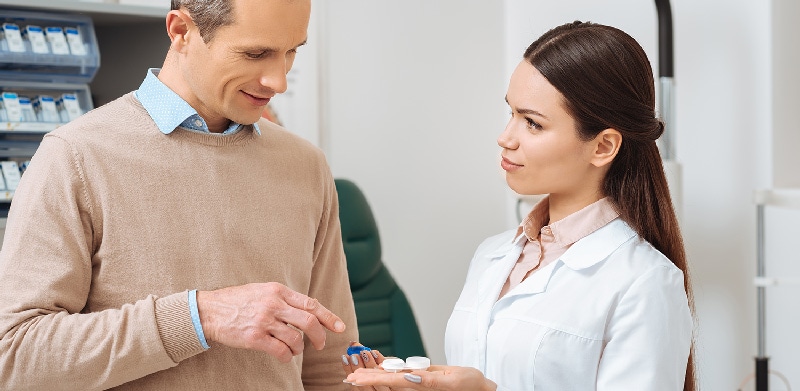Contact lens fitting: procedure, cost and follow up

Contacts afford their wearers freedom that glasses cannot match. And as contact lenses become more advanced and affordable, you may be thinking about making the switch. If you’ve been considering getting contacts, the first step is speaking with your optometrist.
What are contact lens fitting and follow-up? Let the experts at Contacts Direct walk you through the process!
What is a contact lens fitting? Procedure step by step
A contact lens fitting is an appointment where your optometrist will assess the fit of the lenses to the curve of your eyes. The contact lens fitting procedure usually follows these steps:
Step one: Eye exam
The first thing your doctor will do is give you a standard contact lens fitting exam. The purpose is to ensure that your prescription is up to date and current. They will also look for any indicators of cataracts, inflammation, or other conditions that can cause complications.
Your doctor will also perform a pressure check to ensure that your eyes are healthy and that you’re not suffering from dry eyes or spots in your vision. Next, your doctor will perform a retinal scan to spot other potential problems early on. All these steps are standard and are nothing to worry about.
Step two: Contact lens consultation
After your eyes have been screened, your doctor will determine your prescription. Contact prescriptions can be a bit challenging to understand, but rest assured, they are written in a particular way to ensure that you get the safest, most comfortable lenses possible.
Once your prescription has been determined, next is your contact lens consultation. This step is to help determine your candidacy for wearing contacts and takes into account a variety of considerations. Some factors can influence your candidacy, such as astigmatism. These considerations may limit your selection; however, they don’t necessarily mean you can’t get contacts. There are a variety of specialty contacts designed for eyes with astigmatism and other limiting circumstances. Once it’s been determined that you can get contact lenses, your doctor will then ask a series of questions to determine the best type of contacts to suggest, such as general lifestyle choices, preferences, and your interest in daily disposables or other types of lenses.
Step three: Choosing the right lenses for you
Once your doctor has determined that contact lenses are a good fit for you and your eyes, it’s time to pick! There are a wide variety of lenses to choose from, and each has its advantages and drawbacks. Speak with your doctor about your lifestyle and preferences, and they will help you decide on the perfect fit. Whether you’re interested in daily disposables or monthly lenses, there’s a perfect pair out there for you.
Step four: Learn about your contacts
Finally, once you’ve figured out the right brand and style of contacts for you, it’s time to learn how to use them. Putting contacts in for the first time can be a little intimidating, but after a few times, you’ll become an expert. While contacts can make life much easier in the long run, there are certain things you need to know before you first put them in your eyes. There are plenty of Dos and Don’ts of wearing contacts, and it’s important to understand them. From how to clean your contacts properly, to how long you can keep your lenses in, learning these now will save you frustration in the future.
Contact lens fitting cost
Fittings are not always covered by insurance, so you should check your coverage with your insurance provider. Contact lens fittings cost between $25 and $250, depending on where you live, which clinic you visit, and which lenses you need. For contacts for astigmatism, for example, or other less common eye conditions, fittings are more complicated.
What is the difference compared to a regular eye exam?
The objective of a regular eye exam is to diagnose the refractive error that needs to be corrected, whereas a contact lens fitting aims to make sure that the lenses that you’ve been prescribed fit properly on the surface of your eyes.
Why do I need a contact lens fitting
Your eye doctor will examine your eye health during the fitting and retake your measurements to make sure the lenses you have been prescribed fit comfortably and are sufficient for correcting your refractive error.
At Contacts Direct, we offer the best name brand contacts at the best prices. Our experts get your orders shipped quickly and effectively, so you can start seeing your best sooner. We make it easy to use your insurance and are happy to answer any questions you might have. Contact us today to learn more, or go to ContactsDirect.com


